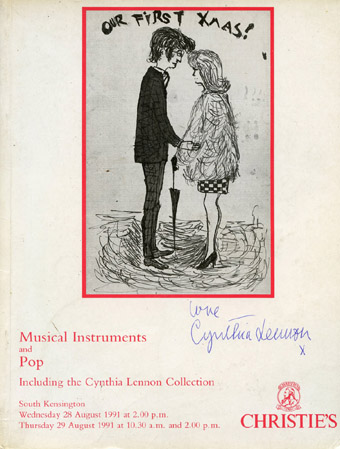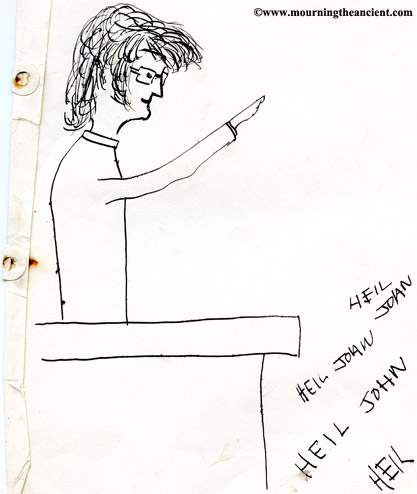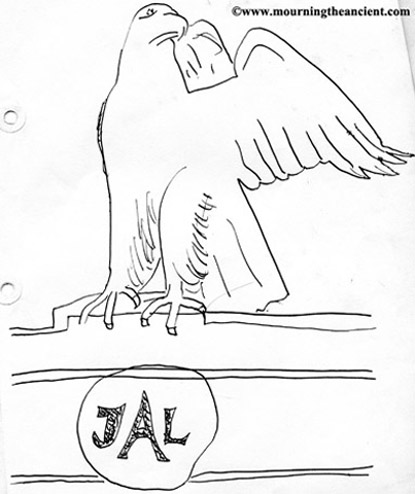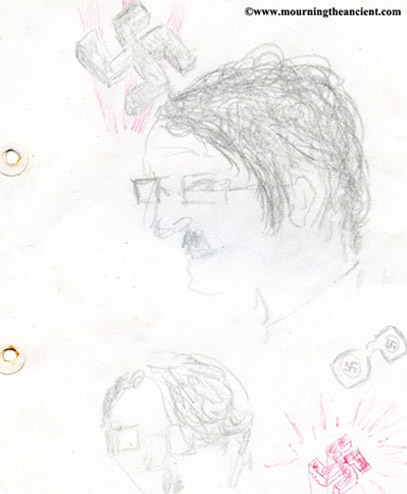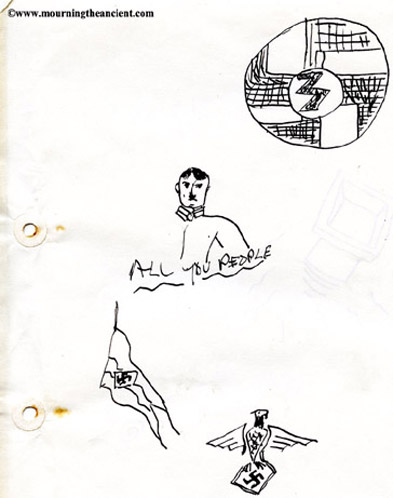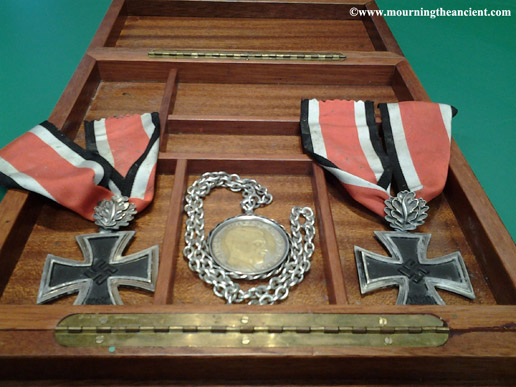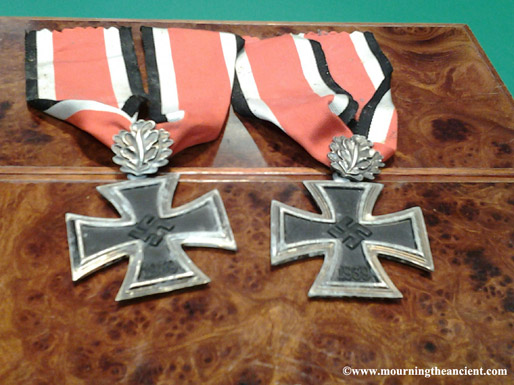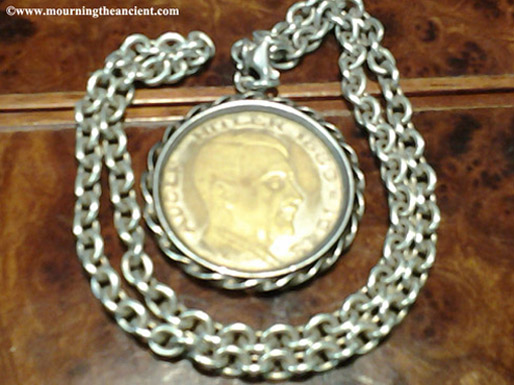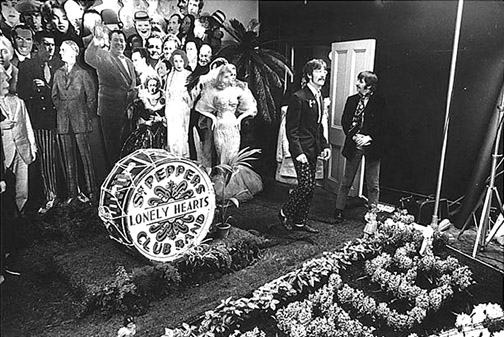"I'm sorry for that stupid patronising comment," I replied. I really was. I meant it. Digging myself deeper into the hole, I went on.
"It's just the heat is exhausting me, and I've spent half a day in another sales room examining fake Adolf Hitler paintings and it's depressed me."
"You're forgiven," she replied, still with a lovely big smile and that Wirral accent.
"So you're a valuer, and you value Nazi items?"
"I do," I replied. By this time I was quite humble and more than groveling.
"So I should come to you then, if I wanted any such items valued?"
"There are other valuers, who will also..."
"There probably are," she cut me short. "Hmmmm."
"You know, John was absolutely fascinated by Adolf Hitler. As a boy he used to collect and swap those Nazi badges, medals, daggers and things. He used to call himself John 'Adolf' Lennon, you know, instead of Winston... (he was named after Winston Churchill, the British Prime Minister)"
"I didn't know all this, really didn't" I replied.
"Oh, yes," she went on, "I can remember him telling me that Hitler was like a modern day Jesus Christ figure and how he took on the world... and nearly won..." she said this latter part raising her eyebrows, a smile playing on her lips.
"It could of just been that he saw him as a rebel, working class figure just serving his people," I intoned, "...and presenting some identification against the..."
"Oh no, it was deeper than that... much deeper..."
"Can I trust you to value some items of John's he gave me, and dispose of them. I told Christie's about them, but they told me they don't auction Nazi items. It's not much, just some drawings John did of himself at college, you know... 'in that guise'... and some medals he had left. They are still in the box he kept them in."
"I would be delighted to, really would," I said.
With that I gave her my address and telephone number and she kindly signed the front of my catalogue for me.
About a month later, the drawings/medals arrived. I explained to her the importance of the provenance and how they could only be sold if she agreed to this. After a brief chat, very breezy, she agreed that I could buy them personally from her on the very strict understanding that I would only sell them after she had died. This I faithfully agreed to.
Sadly, Cynthia Lennon, née Powell, died on the 1st of April, 2015, age 75, after a short battle with cancer. Her last husband Nöel Charles, preceded her by two years.
Before we examine the drawings and artifacts of John's, let me give a mere few words on Cynthia. I found her truly wonderful. I could have dated her. I felt she was so ready to give and accept love. She was so 'glowing', and with that tantalising smile. I'll never forget her. She was desperately unable to control her finances and had racked up bills galore. I do feel so guilty now that I hadn't given her more for those items. At the time it was just above market price. I asked her twice for me to obtain another two valuations for her. But she refused.
As we all stumble on the journey of life, we think of not only loves we have experienced, but those we have not. It's usually the latter that gives us the regrets. With Cynthia... maybe, just maybe... I should have asked her... but she was married and I really wanted to be very professional for her. But I regret it now, I really do. She was like a butterfly that fluttered briefly, all too briefly, into my life on that warm August day. I correctly, as I had to do, opened the window for her to fly out again. Is life, love and passion like that? ...but should I just be grateful for her brief 'flight' into my life?
Anyway, to examine the items of a young John Lennon.
Let's deal first with the drawings. These are now considered explosive. They were executed by John during his Art School period, roughly late 1950s, say 1958ish. Some probably earlier, say 1956/7. They are drawn and doodled on his ringed sketch book. The 'style' is typical of the very early Lennon before his now well known 'comic line style'. Notwithstanding, we can see in them the early development of this style rapidly emerging. I'll go into my 'valuer mode' to examine them, page by page.
1. The most significant is obviously the pen and ink drawing of John taking the salute in Adolf Hitler style on a podium with the cries of "Heil John, Heil John," from the invisible crowd below. It's a fine, and very rare self portrait, confidently line executed. It obviously bears close similarity with the self portrait he executed on the hand-made Christmas card for Cynthia in the Christie's sale and drawn in the same confident manner, albeit in 'line-out form'. It's that image though which is so arresting. John Lennon seeing himself as Adolf Hitler. Not only does it express the youthful John's almost adoration but also perhaps his inspiration. This hero of the people. The unknown man becoming almost obsessively known. 'The working class hero is something to be' (title from one of John's later songs). Did this drive John on? It must have played a huge influence on the insecure youthful life of the early Lennon.
2. The second most significant drawing from the collection is the pen and ink drawing of the Third Reich Nuremberg eagle, with, instead of the swastika in the circular cartouche, the initials of 'J.A.L.' for John 'Adolf' Lennon. We know that John had 'difficulties' with his middle name of 'Winston'. Not only did he not like Winston Churchill, but also regarded him as a prime example, if not 'the' prime example, of the stultifying British establishment that John hated, and had struggled against, so much and for so long. For the young John, Adolf Hitler, Churchill's deadly opponent would easily seem the direct opposite and one he could so much more readily identify with. Like him--lower middle class, dynamic, vibrant, adored (and needing to be adored) making and moving history, and above all--modern. John Lennon and Adolf Hitler came from the adoring crowd and yet were different from them. Finally, John did do away with the ghost of 'Winston', by changing it to 'Ono' by deed poll on April 22, 1969. The exorcism was complete.
3. The third most significant drawing is the pencil(s) head portrait of Adolf Hitler wearing John's 'Buddy Holly' type glasses. John had tousled Adolf Hitler's hair and portrayed him 'smiling'. It is obviously only a supposition, and I will leave it completely open to conjecture, but is this John again seeing himself as Adolf Hitler, or perhaps, more interestingly, how Adolf Hitler would look in the 'beat' times of the late 1950s? Both are fascinating thoughts. Around the 'heads' are two searchlight thrown swastikas and a pair of John's glasses with swastikas peering out instead of eyes. The reverse of this page contains a number of doodles of guitars, frets, and John's entwined initials as music scores, etc., executed in red. These need not detain us here except to show the musical genius and culture revolutionary that John would become.
4. The fourth and final page is the four pen and ink sketches. Three of Nazi insignia, one a line drawing of Adolf Hitler again with the wording of 'All you people' underneath in John's typical scratchy writing. If we look more closely though they become more interesting.
The circular badge on the upper right is a representation of the D.J.V. membership badge. Almost certainly from John's collection. However, instead of the D.J.V. lightning flash, John has changed it to a flashing 'J' for John. The 'flag sketch' is of a HJ pennant, and the third emblem appears to be the stylised national emblem used by the NS Lehrerbund (National Socialist Teachers' Alliance), again, probably taken from the circular membership badge in his collection. All these items were common and cheap to buy/swap in the mid/late 1950s in Britain.
Now to that wording under the Adolf Hitler sketch.
Am I being too fanciful to suggest this could well be the forerunner of 'Power to the People' -- one of John's later songs? Certainly, such thoughts were always in John's mind, even as we can see, from this early stage. Once again, am I being too fanciful, to suggest that it was this generic force in his life that first attracted him to Adolf Hitler, and further, which I will reference later in this entry, remained a part of him and was indeed embedded in his psyché? It's fascinating.
5) The two Knight's Crosses with Oak leaf clusters of John Lennon's.
In the compartmentalised burr-amboyna wood box where John kept his Third Reich badges and medals remain his two Knight's Crosses. These, I will correctly identify, are period 'tailor's display examples'. They are of one-piece construction, un-maker marked, have a nice, sharp, high swastika and good sharp ribbed inner rim. It is silver plated and painted tombak bronze. Ditto the oak leaves. Typical of their type. These would have been displayed on a military tunic in any outfitters in any town or city in the Third Reich, still on the same ribbon(s) seen here.
They have since acquired a nice, untouched, age patination. John would have almost certainly acquired these quite readily among the many 'swaps' and 'exchanges' during this period. Remember, the collectors market didn't exist then. There were no published reference books. You simply asked veterans if they brought any souvenirs back. There was, correspondingly, no price structure. You simply went on immediate attractiveness. One Knight's Cross looked very much like another. Indeed, it's not inconceivable that John would have even worn these around his neck. Which leads me on to something quite special, which John definitely wore around his neck, all the time. I can vouch for this, as Cynthia told me.
6) John Lennon's Adolf Hitler Commemorative Medallion.
This large version of the Adolf Hitler Commemorative Medallion at 3.5 cts diameter is in die struck tombak-bronze, with an image of Adolf Hitler, his birth and death dates (1889-1945) on the obverse, with the National Third Reich emblem and rallying slogan 'Ein Volk, Ein Reich, Ein Führer' on the reverse. Those were first 'minted' in the immediate years after the war, say 1947-49 in this tombak-bronze version, thence in white metal and even alloy afterwards. I'm told that solid nickel, or coin silver examples also exist but I've never encountered them. This tombak-bronze version of John's was invariably silver-plated or 'silvered'.
[Above: Front]
Who manufactured them? Why did they manufacture them? How were they sold and to whom? Hmmmm, interesting questions of which sadly I can only give part, and even then, unverified answers.
The 'lore' is these early plated tombak-bronze versions were produced on professional minting presses by surviving National Socialists in Austria, initially to sell/trade to the occupation authorities who were hungry for souvenirs of the Hitler period. They obviously went through the occupation zones of Germany and the returning de-mobilised personnel to Britain. This is almost certainly how John, living in the busy port city of Liverpool would have acquired his. His example is contained in its period 1950s clasp with typical 1950s style continuous twisted decoration around the rim. Unmarked, but tests for .800 grade silver. The chain is later, say 1970s/80s. I know this as Cynthia told me she attached it herself!
[Above: Back]
The medallion has obviously been extensively worn by John, as most of the 'silvering' has worn off, has a nice age patination with typical 'rubbing' to the highlights.
As Cynthia told it to me -- "John wore this around his neck continuously. It's a unique personal item of his which he had a deep attachment to in those youthful years."
Was it just the youthful years? Was it just a passing phase that most mainstream commentators know about but refuse to admit? Did it lapse when John became famous with the Beatles?
Well......
John desperately wanted to put Adolf Hitler on the cover of the famous album alongside the other luminaries. The rest of the Beatles had reluctantly agreed to his choice of Aleister Crowley but balked at Adolf Hitler.
Unknown to the three others, John then asked Sir Peter Blake, who designed the famous cover, to put Adolf Hitler "in the most important part behind the band". Thinking it was purely a mischievous joke Sir Peter agreed.
It's the standard Hoffmann photo of Adolf Hitler and I understand it's fully visible in the transparencies. Needless to say it's the largest 'famous person' photo on the cover.
Sir Peter Blake confirmed the Adolf Hitler 'hidden' inclusion fully in his interview with the Independent newspaper of 4-2-2007 [February 4, 2007].
[Above: Cut-out of Adolf Hitler, front row, third from left]
'Hitler behind the band' Seen in the light of John's young passion for Adolf Hitler, which I really believe was a major driving force in his life. John Lennon was the major creative driving force of the Beatles. The one that gave them that unique 'edge' and restless creative energy. Without him I think they would have just 'blanded out' into the numerous boy bands of the Mersey Sound in the 1960s. I'm not constructing a febrile concept when I say that for John, Adolf Hitler behind the band was so appropriate. Indeed, that's why John put him there.
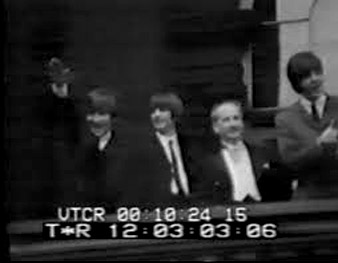
[Above: John Lennon giving the 'Hitler salute' to his adoring fans. He did this many times throughout his career.]
"I hope you have enjoyed this article" (a deft, if somewhat predictable recording of the second line of the Sgt. Pepper song!)
This is the first, and only occasion that these very rare items with the accompanying text will appear on-line. I have written and shown them exclusively to Mourning the Ancient and, more importantly to the MTA readers. This site, is like no other on the web. Unique. In many ways, I feel I'm doing it with John's blessing. He would have loved it. Like him it challenges everything. From the stupid Judeo-Christian capitalist concepts that enmesh us all, to the provocative nudity that mirrors John and Yoko's provocative nudity. 'All we are saying is give truth a chance'.
Dedicated: To Molly of MTA who, like John Lennon, questions everything and accepts nothing, and again like John, successfully escaped being a prisoner of her past.
From Mike and Earl
to you all.
-:-Read part two of this article and see a selection of Lennon's nude sketches-:-
